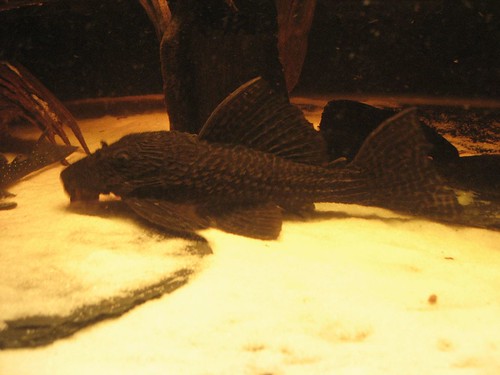Megalancistrus cf. barrae Pleco Profile
Scientific Name : Megalancistrus cf. barrae
Family : Loricariidae
Common Name : Mega
Common Name : Mega
Things to note: Megas grow to become one of the biggest available plecos. Coupled with its notoriously boisterous nature, it is better as the sole display specimen, or commed with larger plecos.
Personal comments : I am drawn to the Mega not only because it has a very strong personality, but also because it seems to glow a wonderful gold colour when settled. [Afternote] I have gotten my mega, and I can assure you this: it's even more beautiful than I thought! The spikes are glorious, and amazingly only the spikes are yellow; the body base is dark. This gives my Mega a shimmery kind of colour texture.. Amazing!
Tips : Grab one wherever you see one! Rare and beautiful beyond belief.
......................................................................................
Sexing and Breeding : Not Known
Feeding : The mega is an omnivore. It will happily accept prawn, mussels, cockle and small pieces of fish. Large bloodworms are also welcome. It needs vegetable matter in its diet and will eat cucumber, spinach, potato and sweet potato. Provide fruit, such as mango, as a delicacy.
Behaviour in Captivity : Extremely aggressive fish, ready to defend its supremacy in the tank with fights. Territorial disputes are quite common. It is likely to stress other less aggressive or smaller bottom dwelling fish. To make it moderate its behaviour ensure it is not the biggest bottom dweller in your tank.
Like many larger plecos, this up to 20" fish from Eastern Brazil can be very territorial. Larger specimens can injure each other during fights. Because of their extremely sharp spines, they must be handled with care. If you must pick one up, hold it by the head or pectoral fins. Grabbing it by the tail can cause it to panic, resulting in injury either to the fish or the fishkeeper. Any stone structures or driftwood used must be securely fastened, as fish this strong can easily collapse poorly constructed tank decor. On the positive side, Megaancistrus are excellent fish for aquaria with large territorial cichlids like Crenicichla or Cichlasomines. However, you must take care to be sure your catfish get enough food (frozen shrimp, bloodworm and vegetables).

1 comment:
Good words.
Post a Comment